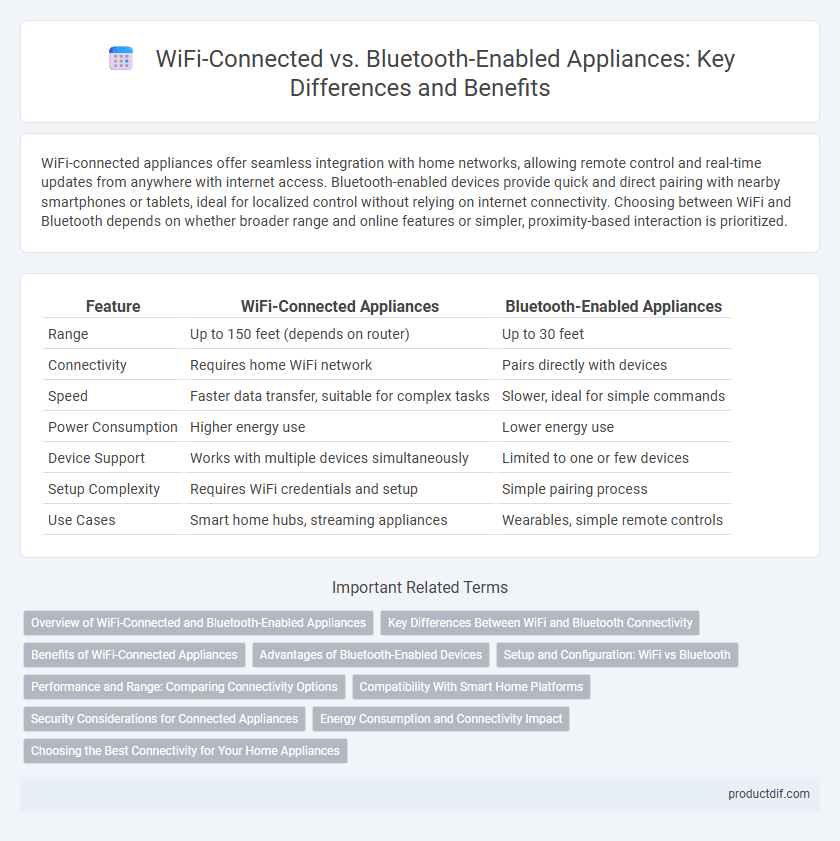WiFi-connected appliances offer seamless integration with home networks, allowing remote control and real-time updates from anywhere with internet access. Bluetooth-enabled devices provide quick and direct pairing with nearby smartphones or tablets, ideal for localized control without relying on internet connectivity. Choosing between WiFi and Bluetooth depends on whether broader range and online features or simpler, proximity-based interaction is prioritized.
Table of Comparison
| Feature | WiFi-Connected Appliances | Bluetooth-Enabled Appliances |
|---|---|---|
| Range | Up to 150 feet (depends on router) | Up to 30 feet |
| Connectivity | Requires home WiFi network | Pairs directly with devices |
| Speed | Faster data transfer, suitable for complex tasks | Slower, ideal for simple commands |
| Power Consumption | Higher energy use | Lower energy use |
| Device Support | Works with multiple devices simultaneously | Limited to one or few devices |
| Setup Complexity | Requires WiFi credentials and setup | Simple pairing process |
| Use Cases | Smart home hubs, streaming appliances | Wearables, simple remote controls |
Overview of WiFi-Connected and Bluetooth-Enabled Appliances
WiFi-connected appliances offer seamless internet access, enabling remote control, firmware updates, and integration with smart home ecosystems for enhanced convenience and automation. Bluetooth-enabled appliances provide direct device pairing with low power consumption, ideal for proximity-based control and short-range communication without relying on internet connectivity. Both technologies support smart appliance functionality but differ in range, connectivity stability, and application scenarios.
Key Differences Between WiFi and Bluetooth Connectivity
WiFi connectivity offers a broader range, higher data transfer speeds, and supports multiple device connections simultaneously, making it ideal for smart appliances requiring constant internet access. Bluetooth-enabled appliances prioritize low power consumption and ease of direct device pairing, providing efficient short-range communication without relying on internet connectivity. The choice between WiFi and Bluetooth depends on the appliance's functionality needs, with WiFi suited for complex tasks and Bluetooth optimal for simple, local device interactions.
Benefits of WiFi-Connected Appliances
WiFi-connected appliances offer seamless remote control and monitoring through smartphone apps, enhancing user convenience by allowing operation from anywhere with internet access. These appliances enable real-time updates and integration with smart home ecosystems like Amazon Alexa and Google Assistant, providing automation and voice control capabilities. WiFi connectivity also supports faster data transmission and firmware updates, ensuring appliances remain efficient and secure over time.
Advantages of Bluetooth-Enabled Devices
Bluetooth-enabled appliances offer seamless short-range connectivity, ensuring stable and energy-efficient communication without the need for a WiFi network. These devices excel in low power consumption, extending battery life and enhancing portability in smart home setups. Bluetooth's direct device pairing eliminates dependence on internet access, providing faster response times and increased security for appliance control.
Setup and Configuration: WiFi vs Bluetooth
WiFi-connected appliances require linking to a home network through router settings, enabling remote access and integration with smart home systems. Bluetooth-enabled appliances offer simpler, quicker setup via direct pairing with devices, but typically have limited range and fewer networking features. WiFi setup involves entering network credentials and may support multiple devices, whereas Bluetooth setup usually involves device discovery and pairing codes for one-to-one connections.
Performance and Range: Comparing Connectivity Options
WiFi-connected appliances typically offer superior performance with faster data transfer speeds and wider range coverage, supporting seamless control across larger areas and multiple devices. Bluetooth-enabled appliances provide lower latency ideal for close-proximity interactions but have limited range, usually around 30 feet, which can restrict mobility and connectivity in larger homes. Choosing between WiFi and Bluetooth connectivity depends on the need for extensive coverage and network integration versus simple, short-range device pairing.
Compatibility With Smart Home Platforms
WiFi-connected appliances offer broad compatibility with major smart home platforms like Amazon Alexa, Google Assistant, and Apple HomeKit, enabling seamless integration and remote control. Bluetooth-enabled devices often have limited range and may support fewer ecosystems, restricting interoperability in larger or multi-room setups. Choosing WiFi connectivity enhances smart home automation flexibility and ensures consistent performance across diverse devices.
Security Considerations for Connected Appliances
WiFi-connected appliances typically offer stronger security protocols such as WPA3 encryption, making them less vulnerable to unauthorized access compared to Bluetooth-enabled devices, which often rely on shorter-range, less robust security measures like pairing codes. However, WiFi devices can be targeted through network-based attacks like man-in-the-middle or credential theft, requiring regular firmware updates and strong password policies to mitigate risks. Bluetooth-enabled appliances benefit from limited range reducing exposure but may suffer from vulnerabilities like BlueBorne, emphasizing the need for updated software and secure pairing methods.
Energy Consumption and Connectivity Impact
WiFi-connected appliances typically consume more energy than Bluetooth-enabled devices due to their constant data transmission and stronger signal requirements. Bluetooth technology offers lower power consumption by operating on short-range, low-energy protocols, making it more efficient for simple device connectivity. However, WiFi provides broader connectivity and faster data transfer, which can impact overall energy usage depending on the appliance's network activities.
Choosing the Best Connectivity for Your Home Appliances
WiFi-connected appliances offer broader range and remote access through smartphone apps, making them ideal for monitoring and controlling devices from anywhere. Bluetooth-enabled appliances provide seamless direct pairing with nearby devices, ensuring quick setup and low power consumption suitable for single-room use. Prioritize WiFi for comprehensive smart home integration and Bluetooth for localized, efficient control to optimize appliance connectivity.
WiFi-connected vs Bluetooth-enabled Infographic

 productdif.com
productdif.com